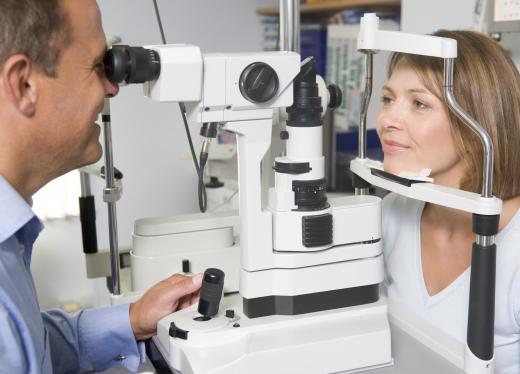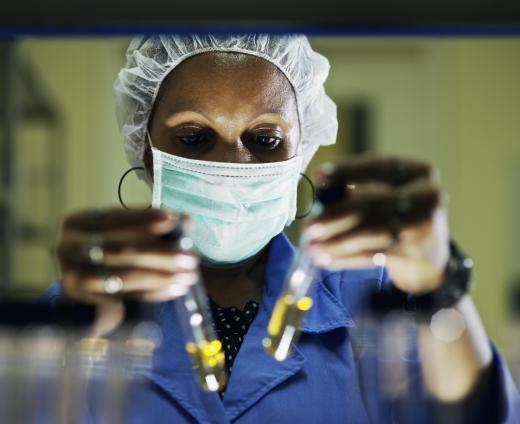What is Fluorescein?
 Mary McMahon
Mary McMahon
Fluorescein is a fluorescent dye which is used in a number of different applications in the sciences and medicine. In pure state, fluorescein is a red or orange powder which is dissolved in alkaline solutions to make up a yellow solution which will glow green. In addition to using straight fluorescein, researchers also work with various derivatives of the compound which are designed to conjugate to specific types of molecules and perform other functions.
In medicine, this compound has a broad range of uses. Ophthalmologists use it in eye exams, staining the eye with the dye to look for signs of tears in the cornea, and they can also use it for fluorescein angiography of the retina, using the dye to look for leaks inside the blood vessels in the eye. The chemical can also be used as a tracer in other areas of the body, and it is utilized in microscopy and as a stain. In addition, fluorescein derivatives are used in the lab to identify compounds in fluid samples, with the chemical attaching to specific proteins to act as a flag.

In laboratory science, fluorescein can be used for protein labeling, and in a number of other tasks. Outside the lab, this dye was historically used to trace river flow and flows of pollutants, although it has been replaced in some regions due to concerns about the environmental impact of these practices. This compound is also used in dye lasers and some other scientific instruments which need to be able to fluoresce.

Oceanographers and hydrologists have historically used fluorescein to trace the flow of currents through bodies of water of interest. In this case, a load known as the “point source” is released in a set location and followed as it moves through the water. In addition to providing data about current flow, the movement of the fluorescein can also be used to trace contaminants, by tagging the contaminant with the compound and watching to see where it goes. This information can be used in environmental cleanup efforts.

Several chemical companies manufacture fluorescein and derivatives of this compound, such as fluorescein isothiocyanate. These companies can sell the product packaged as powder or solution, in various sizes to meet the needs of users. This compound is one of the most widely used fluorescing molecules, and numerous photographs featuring this chemical compound in action can be found on scientific websites.
AS FEATURED ON:
AS FEATURED ON:













Discussion Comments
Can you tell me if the fluorescein dye that is given IV has adenosine in it? I am very allergic to this compound and am due to have a fluorescein angiogram in a few weeks.
@matthewc23 - I am with you. I have only heard about fluorescein in biology. I think it was used a lot to figure out how different pathways in our cells worked. For a long time, scientists couldn't figure out how proteins were formed in our cells. Eventually, they were able to put fluorescent markers on different compounds and found that ribosomes were responsible for moving into and out of the cell nucleus and creating proteins.
You mentioned fireflies. I guess the same principle would apply of a reaction causing a release of light, but I don't think bioluminescence is really fluorescent is it? Just normal light energy.
@jcraig - I had no idea that fluorescein could be used for such a wide range of things. When I have seen it used, it was always in genetics experiments. In those cases, you had to put cells under UV light to see the glow, but I'm not sure how it would work in larger quantities like the river example from the article.
As for what it is made of, I just looked it up, and it is a normal organic compound of carbon, hydrogen, and oxygen. I couldn't tell you how it reacts to make a glow, though. Somehow it would have to make a compound that released energy as light. I think it would kind of be like a lightening bug lighting up.
Thinking about glowing things, is fluorescein used to make the glow sticks you can buy at fairs and concerts? Seems like it would be a reasonable guess. I guess I would have the same question about glow in the dark paints and things like that, too.
Is this stuff something that you could buy online somewhere and play with, or is it considered too dangerous to sell to the public? I would think you could have a lot of fun with it if you had some.
Is fluorescein detection possible with the naked eye, or do the molecules only glow in the dark or under something like a dark light or ultraviolet radiation?
Also, what compounds are used to make fluorescein? Does it have fluorine in it? Just guessing that from the name. I guess I have never really thought about what makes something glow before.
Every time I go to the eye doctor for an exam, he always puts drops in my eyes and I would always have a yellowish residue when I wiped my eyes the rest of the day.
Now I know that is a fluorescein dye that he uses to check my cornea. Even though these drops don't really sting when they are put in my eye, I knew they weren't just regular eye drops.
It is amazing how dyes like this can really make any abnormalities show up. I wonder if the drops that contain the fluorescein are also what makes my eyes dilated, or if they use something else for that?
Post your comments